Actual on-farm cow liveweights have replaced the use of cull cow weights as a predictor of liveweight. This has resulted in a maintenance sub-index that better reflects maintenance feed intake costs.
What is the maintenance sub-index?
The maintenance sub-index represents 8% of the overall EBI (Figure 1). It gives an indication of the expected cost of growing a replacement female and maintaining her as a cow in the dairy herd due to her genetic make-up. In simple terms, the maintenance could be described as the cost of keeping a cow, without her producing anything in return (e.g. milk).
What is the change?
Since 2010, the maintenance sub-index used cull cow weight records to generate the maintenance sub-index. Although cow liveweight has long been considered the preferable trait for predicting maintenance costs, cow live weight records were not abundantly recorded when the sub-index was developed.
Recently, however, over 1 million dairy live weights have been recorded on the ICBF database. Weight data from dairy cows sold through the mart has increased in recent years as has the quantity of farmers themselves weighing and recording liveweights on the ICBF database. Other projects, such as GREENBREED (a DAFM funded project in which ICBF and industry-partners are striving to improve the environmental sustainability of agricultural systems) have contributed significantly to the additional availability of liveweight records.
Due to the extra data, ICBF is now in an opportunity to provide a maintenance sub-index that is based on actual live weight records, instead of cull cow records alone. The updated maintenance sub-index has been available since January.

What does the change mean for my herd?

At a breed level, the average maintenance sub-index has change is about +€1 for Holstein/Friesian and -€16 for Jersey. The changes reflect the impact of kill-out % differences between the breeds. On-farm liveweights have indicated that Jersey cows are on average 21kgs heavier, than what was previously predicted based on a standard kill-out % from cull cow carcass weights.
What does the €uro value mean?
A higher maintenance sub-index equates to a smaller cow, one which typically has a lower maintenance cost. This is particularly of interest to Irish grass-based dairy farms who wish to focus on reducing mature-cow liveweight for a more carbon efficient animal. Levels of feed intake are an important factor influencing methane production. Smaller cows typically consume less feed than larger cows, and these can produce the same level of production.
The maintenance sub-index can be used as a rough guide to predict mature cow-live weight. For example, as maintenance sub-index increases by €1 it is expected cow live weight will reduce by 4.98 kg for a 3rd lactation Holstein-Friesian cow in mid-lactation (Table 1). These changes do not cause a change in beef sub index in EBI.
How can I record live weights of my herd?
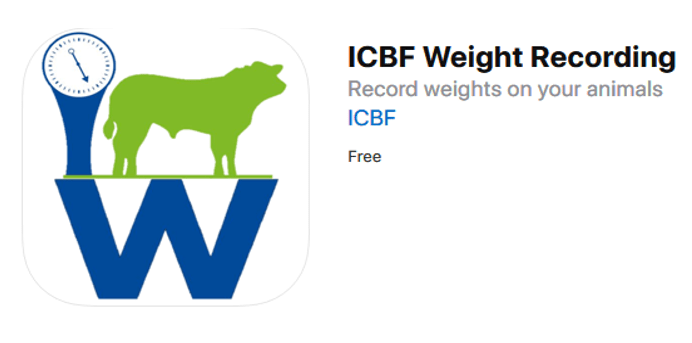 Liveweights can now be recorded now quite easily on ICBF by all farmers. Last year a herd specific weight recording App was made available for free download (Android & Apple app stores).
Liveweights can now be recorded now quite easily on ICBF by all farmers. Last year a herd specific weight recording App was made available for free download (Android & Apple app stores).
Both dairy & beef farmers alike can use this app on farm. Data goes directly into the database if recorded on farm.
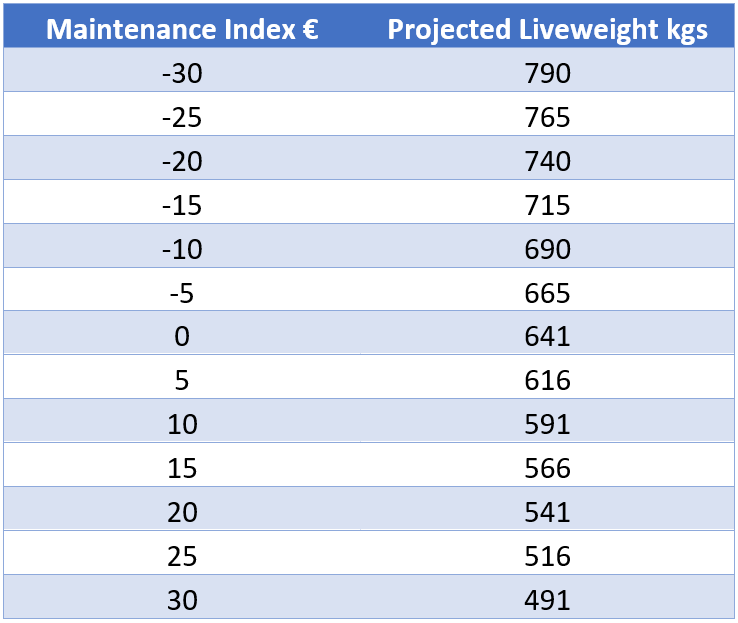
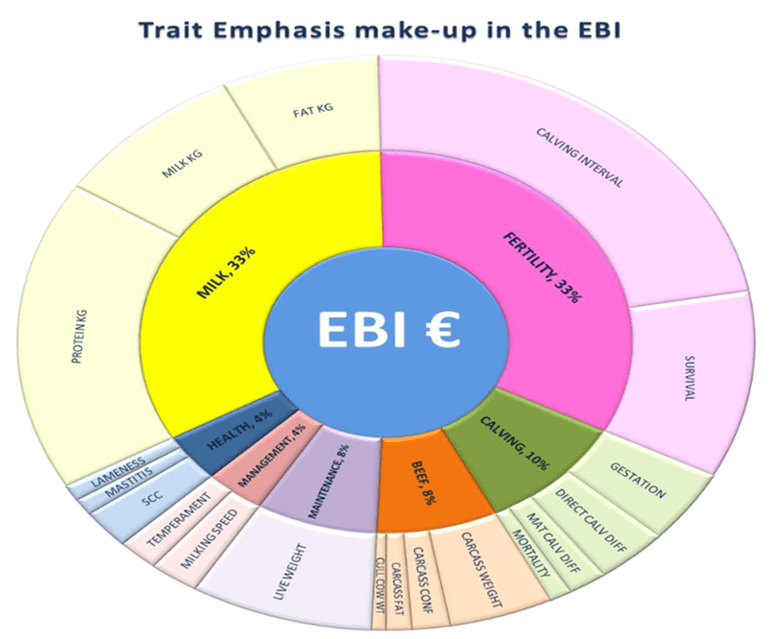
Advice for Farmers
For dairy farmers who wish to continue breeding higher quality dairy beef calves for example, they should keep in mind both the maintenance & beef sub index of existing cows at EBI herd level. This is outlined in HerdPlus EBI reports as highlighted below.
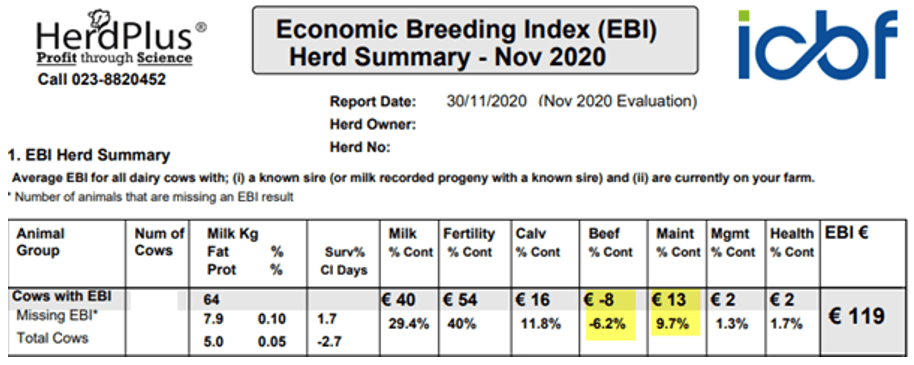
We would encourage all dairy farmers to consider beef merit, when selecting beef and potentially dairy bulls for use in your herd going forward. This is critical to help establish greater integration between our beef and dairy industries in the future. To breed higher quality beef sired animals, select beef AI sires from the DBI (Dairy Beef Index) Active Bull List (www.icbf.com), that are positive for beef carcass traits. Bulls with higher beef merit figures should be considered for more mature cows. This Spring, EBI scorecards were sent to all dairy farmers to highlight their herd status regarding beef merit. If your herd EBI is low for these traits, then using dairy bulls that will improve beef merit into the future should be considered. If dairy farmers are content with both existing cow and calf size in general, then selecting sires that are comparable to your current EBI herd level for maintenance & beef sub index is advised.
To assist our HerdPlus members to focus on identifying females that are both good & poor on carcase merit, ICBF launched a new Carcass Merit Profile earlier this year. This new profile display’s carcase merit of all animals in your herd.
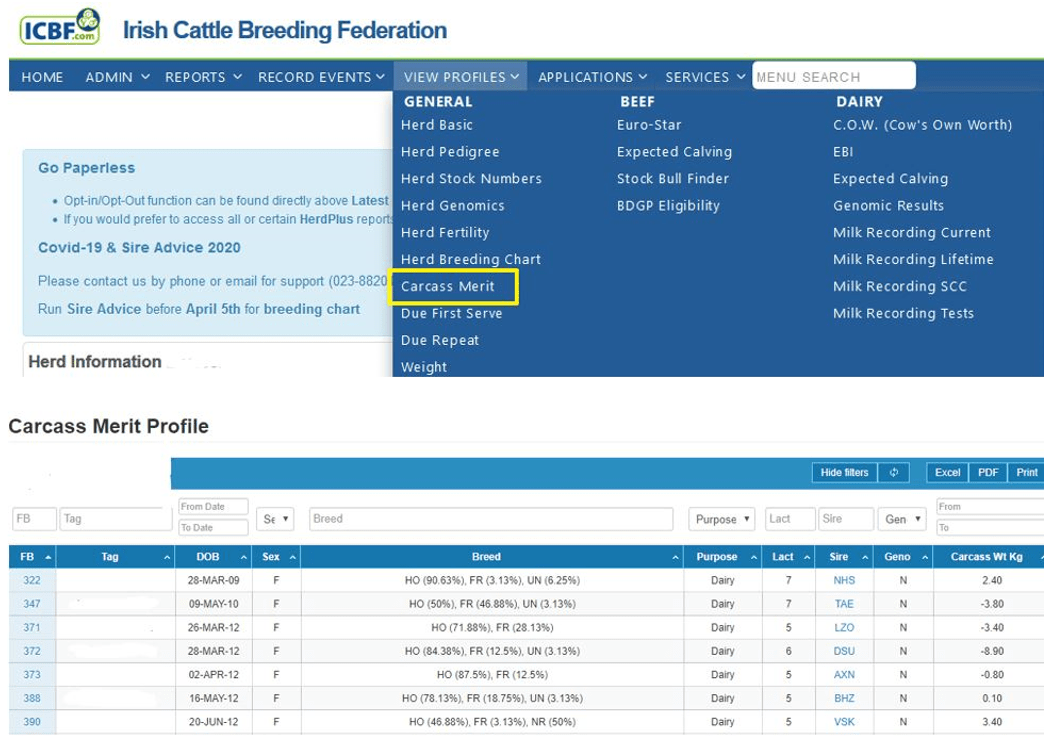
Please also note maintenance calculator that you can use for your own herd. The calculator projects a mature weight of a third calving cow in mid-lactation. Refer to your herd EBI report for your herd maintenance EBI sub index. Credit George Ramsbottom, Teagasc Oakpark in relation to maintenance excel calculator.
Summary
EBI can be used to breed lower maintenance cows that produce the same output. Genetic gain is cumulative and permanent, so the gains achieved in EBI continue to add up and last permanently. EBI can be used to breed a more carbon efficient cow that produces high kg of milk solids. This will be important for breeding lower methane producing animals into the future.

